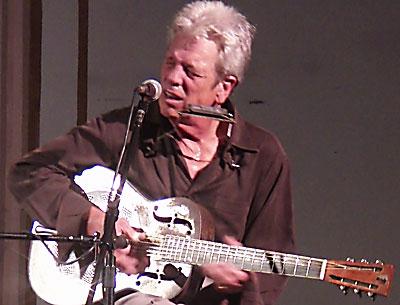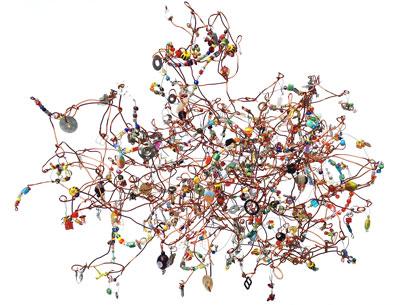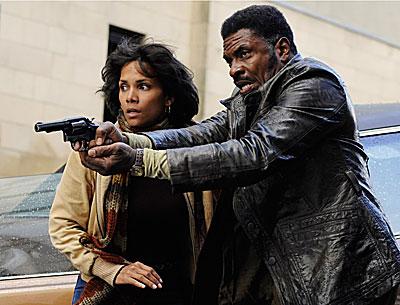Festival Previews: A Short List of What to See
Festival Previews: A Short List of What to See

With so many films to choose from, how does one make a choice among the smaller, independent films that may never make it to distribution? The following is an opinionated sampling of the feature films available for preview before the festival.
“Big Boys Gone Bananas!*”
Fredrik Gertten
Southampton, Saturday, 1:45 p.m.; East Hampton, Monday, 8:45 p.m.
“Documentarians tend to traffic in misery and horror,” says one Los Angeles Film Festival juror in the movie “Big Boys Gone Bananas!*”“I’ve been to many films like that but never one that had this feeling that the room could kind of blow up.”
This is what happens at a screening at the Los Angeles Film Festival when Frederik Gertten, a Swedish filmmaker, shows his film “Bananas!*” which is critical of the Dole Company for using banned pesticides, according to its workers. Although the film was originally slated to be screened at a major venue at that festival, legal pressure from Dole forced it out of Westwood, where the other major films were being shown, and to the University of California at Los Angeles, in a suburb with no shuttle transportation provided by the festival. One journalist called it “ghettoized.” A disclaimer was read before the showing, lest Dole sue the festival.
This is a classic talking-head, mostly first-person narrative documentary in which a film crew follows the filmmakers as they fight to have their documentary shown and released both in the United States and in their native country. The company eventually sues Mr. Gertten and his colleagues.
The film raises questions about corporate pressure on film distributors and festivals, and the often successful pressure brought to bear on what should be an independent press. For something that appears to be rather dry fodder, the film and its content are consistently compelling as well as informative.
Mr. Gertten does a tricky dance of exhibiting righteous outrage when his free speech is challenged while not saying explicitly whether Dole’s claims are valid. It’s an interesting gamble that often makes the film seem a bit moot if you care about such things. Still, it is a well-made and surprisingly watchable film that rewards audiences in the end. J.L.
“Decoding Deepak”
Gotham Chopra
East Hampton, Saturday, 1:15 p.m.
“When your dad says he is going to become a monk, you don’t make sense of it, you just roll the camera,” said Gotham Chopra, the director, screenwriter, subject, co-producer, and son of Deepak Chopra, the internationally known spiritual guru. His ordainment as a Buddhist monk in Thailand is just one setting of the father-son journey. Others include India, Sedona, Ariz., and New York City. During the process, it becomes clear that the world’s perception of Gotham’s father doesn’t align with his own.
The film reveals the philosopher’s colorful contradictions — he likes sparkly sunglasses and red sneakers — and aspects of some who follow him, like Lady Gaga and the late Michael Jackson.
Glimpses of family life in hotel rooms and green rooms from the director’s childhood to the present show how “the line between business and family is permanently blurred,” as well as the privileged son’s struggle with his own identity, after “inheriting a personality that wasn’t my own, and products I didn’t really buy.”
With varied tones and priceless snapshots, including one of a half-dressed young Deepak holding a beer during his partying days, the audience should be kept engaged by the scenery, story lines, and mixed messages. C.A.S.
“Electrick Children”
Rebecca Thomas
East Hampton, today, 3:30 p.m.; tomorrow, 5:15 p.m.
The immaculate conception is a story that predates its biblical telling, and whether you believe Jesus was conceived via the spirit of God, or the whole thing was trumped up to save Joseph’s wife from scandal, it’s an intriguing tale.
Rebecca Thomas, writer and director of “Electrick Children,” has cast it in a funadamalist Mormon family in Utah against Utah’s dramatic vistas. Rachel is an innocent 15-year-old who believes her womb has been implanted with God’s seed by way of a song she hears on her brother’s tape player, a tape player on which her father earlier recorded her sacred pledge to Jesus Christ and the Mormon Church.
This film is not as corny as it might sound. Strong performances by Julia Garner, Rory Culkin, Liam Aiken, Bill Sage, and Billy Zane add present-day substance to a mystery that has intrigued Christians and non-Christians for millennia. A dark counterpart completes the picture. R.D.
“56 Up”
Michael Apted
East Hampton, tomorrow, 9 p.m.
Sag Harbor, Sunday, 5:30 p.m.
How do you measure a life? For Michael Apted, in meters of unspooling celluloid. He’s done so for a number of United Kingdom residents, tracing their lives with candid interviews conducted every seven years and shown on British television, starting when they were 7 in 1964 and reaching the 56-year mark in his latest film, “56 Up.”
As his subjects take stock of their lives, the number of failed marriages described is striking, particularly when intercut with interviews from years before, when skepticism of the institution was voiced by so many of the young interviewees. Yet the impulse remains. It’s the theme of the age. That and making do, which in some instances has become scraping by.
Take Jackie, married at 21, divorced at 35, with three kids from two relationships. She’s been on disability for 14 years. We hear the filmmaker’s voice from off camera ask, topically, about how the government’s new austerity measures will affect her, and the answer is, severely. She’ll be dependent on her sons and other family. On the bright side, that doesn’t stop her from searching the Internet for a date.
Throughout this unprecedented project, an engrossing look into the travails and sometimes triumphs of the beleaguered middle class, the transformations of appearance (added girth, thinned hair) and perspective can be as bracing as they are moving. Some subjects even revolt against the unblinking eye of the camera. Neil protests that one cannot know another’s life. Peter, who quit the project at age 28 after being lambasted in the press for daring to criticize then-Prime Minister Margaret Thatcher, returns to turn the camera to his own purposes and promote his band. B.G.
“James Salter: A Sport and
a Pastime”
Edgar Howard, Sandy Gotham Meehan, Tom Piper
East Hampton, Sunday, 3:30 p.m.
This one-hour documentary is a love letter from the filmmakers to James Salter, and in particular to the Bridgehampton resident’s great 1967 novel of France, romance, and eroticism, “A Sport and a Pastime.”
The question is, to what end? Evangelism? To pull you under the sway of the master? If you’ve never read Salter, you are likely to be unmoved, which is too bad, as the book is one of the most affecting ever written by an American. Reading snippets doesn’t do justice to the writing, and neither does the somewhat drawled delivery of the reader, the late Reynolds Price, to whom the film is dedicated and whose blurb appears on every copy of the book.
The story involves Dean, a Yale dropout, and Anne-Marie, who is provincial and 18. Their affair is conducted in hotels across the French countryside, as relayed, dreamlike, by a third party, Dean’s friend. He can’t have seen or known all he describes, or has it all been imagined? Speakers in the film — critics and other authors — speculate on this. What’s more, locations in the novel are shown, Salter’s long-ago visit to the village of Autun is revisited, and we learn that he drove a car nearly as elegant as the novel’s Delahaye coupe. But explicating the mystery only diminishes it. It doesn’t benefit the reader or the work to know whether Anne-Marie actually existed.
Salter fans will find nuggets of interest, as when he tells a book group in Autun that deciding to use a narrator was difficult, and that once he’d established the tone, he was off and writing. And those narrow, cobbled streets and wooden shutters are awfully charming, aren’t they? B.G.
“Lumpy”
Ted Koland
East Hampton, Tomorrow 8 p.m.; Saturday 3:15 p.m.
Lumpy’s turn as a best man takes a turn for the tragic when he dies during his best friend’s destination wedding. After the newlywed couple, played by Justin Long and Jess Wexler, cancel their honeymoon to arrange for his funeral, they begin to learn much more about their friend’s complicated and unconventional life.
The film, based in Minnesota, touches on a variety of contemporary issues such as disaffected veterans, drug abuse both for fun and for problems, the soullessness of the workplace and the American school system, and the stress and pressures of the beginnings of married life.
As bizarre as the circumstances sometimes seem, the writing and characters make the film believable and true. And with so much sadness at its core, the ending provides some affirmation about life, dreams, and hope. J.L.
“Mondays at Racine”
Cynthia Wade
Saturday 10:45 a.m., Sunday 7:30 p.m., Monday at 2 p.m. East Hampton
Beauty that runs much deeper than skin and hair is captured within the walls of a salon in Islip that offers complimentary support once every month to women suffering from breast cancer.
The documentary’s powerful images portray the trauma experienced by those who have chosen to be treated with chemotherapy and who suffer the devastating consequences, such as hair loss. Light is also shed on other side effects of the disease and its most common treatments, including the toll taken on relationships and self-esteem of those who choose mastectomies.
There is no shortage of moving moments, with real-life survivors from varied backgrounds and ages shown during vulnerable moments in their struggle. Empathetic salon owners hold their hands as their heads are shaved. The film displays a true understanding of the difference that emotional support can provide.
A screening with panel discussion will be offered after Monday’s 2 p.m. screening. C.A.S.
“The New Public”
Jyllian Gunther
East Hampton, Today 5:15 p.m., Sunday 5:45 p.m.
The daily triumphs and struggles of life in an inner-city neighborhood are on stark display in “The New Public,” a powerful documentary of Brooklyn Community Arts and Media High School, a public high school established in Bedford-Stuyvesant in 2006. One of more than 300 small, theme-based schools opened by the City of New York since 2003, B.C.A.M. is the setting for much of the film, which details the freshman and senior years of the school’s inaugural graduating class.
“The New Public” is powerful. Students and faculty alike rush headlong into an academic setting that is new and different, most of them practically giddy with optimism. The verité footage, some shot by students in and around the school as well as in their homes, captures moving portraits of teenagers experiencing their first-ever epiphany. The viewer can actually see the radiance on a student’s face when they are stimulated, challenged, and rise to the occasion.
But unbridled hope soon gives way to reality and its often-accompanying disappointment. Students grow weary of the unfamiliar demands on their time and intellect. Members of the faculty, obviously passionate and committed educators among them, express their own frustration with students, co-workers, and themselves as they navigate terrain that is almost as unfamiliar to them.
“The New Public” vividly illustrates the range of human experience against the backdrop of troubled and often dangerous Bedford-Stuyvesant: a student with a secret he is terrified to reveal; a parent so heavily invested in her son’s academic success that she is regularly brought to tears, and the teachers’ struggles to identify with their students and penetrate the “urban armor” they have all worn from an early age.
As Kevin Greer, a teacher, notes, “You’re dealing with basic inequalities. Our society’s problems are so enormous, and they’re all foisted upon the schools to fix them.” The small victories and crushing defeats that play out in such a Herculean task are dramatically presented in “The New Public.” C.W.
“Rising From Ashes”
T.C. Johnstone
East Hampton, Tomorrow, 4 p.m.; Saturday, 4 p.m.
For most Americans, winning is everything. For a Rwandan, opportunity is everything. There is something refreshing about that. This is a story about Rwanda’s first national cycling team and what can be achieved against all odds — the power to rise from the ashes like a phoenix, when you come from a place recently ravished by genocide.
A bicycle represents freedom in Rwanda, where poverty, crime, and stagnation are commonplace. Freedom to go. To escape.
Jonathan (Jock) Boyer, the first American to ride the Tour de France, a man with problems of his own, harnesses cyclists’ raw talent, as well as their pain and grief, to lead them to compete on the world cycling stage. This story chronicles the team’s development from Day One in 2006, to its race for a potential Olympic berth in 2011.
“Rising From Ashes” covers a lot in 82 minutes. Several elements could be taken separately to create another film (i.e., the colonization of Rwanda, which separated the population into three ethnic groups; the story of Jock Boyer; and the story of each Rwandan team member, including their star rider, Adrien Niyonshuti). Altogether, the separate themes mesh to create a great recipe for an inspirational documentary, just as the team works in harmony to create success.
From the bikes Rwandans ride — most likely discarded relics from a wealthy Western nation — to their love for their beautiful country and curiosity about faraway places, the film gives the impression that Rwanda isn’t so distant. It says we are all connected. L.L.
“Sparrows Dance”
Noah Buschel
East Hampton, tomorrow, 5:30 p.m.; Sunday, 5:30 p.m.
Director and screenwriter Noah Buschel has come up with a wonderful set piece, a sad story that becomes a love story in a warm and fundamental way — a broken toilet.
We don’t know why exactly, but a young woman, a former actress (played by Marin Ireland) has sealed herself off from the world in her apartment. Her face twitches in response to even the slightest stress, and really twitches when no one comes to the aid of a girl being attacked on the street below her window. She is paralyzed with fear.
A door to her reclusive life is opened, literally, when her toilet breaks and she is forced to admit a plumber to fix it. The plumber (actor Paul Sparks) is a saxophone player, oil cast upon the former actress’s turbulent internal sea. “Sparrows Dance” is a highly nuanced film that proves love can sprout in the most unlikely places, even from a broken toilet. A heart-warmer. R.D.
“War Witch”
Kim Nguyen
East Hampton, Tomorrow, 11 a.m.
French with English subtitles
The director and screenwriter Kim Nguyen disposes with exposition, thrusting us into the bleak, war-torn world that is much of Africa today. Mr. Nguyen takes us into the Democratic Republic of Congo, where this film was shot, a land where civilization exists in vestiges.
We follow the preteen Komona, played with a searing sincerity by Rachel Mwanza, on a journey into womanhood that begins with her kidnapping from her village, forced to execute her own parents with an AK-47.
She is taught that her weapon is her new “mama and papa,” as she fights and kills for a rebel leader named the Grand Tigre Royal. She drinks “magic milk,” the hallucinogenic sap from a tree fed to child warriors to make them better killers, and begins to have visions of the dead, allowing her to guide the young troops in battle. Soon she is given the title of War Witch, and is brought to the Grand Tigre himself.
By her side is another child warrior, Magician, played by another brilliant young actor, Serge Kanyinda, who dispenses protective magic while watching over Komona. The two run away, and Mr. Nguyen shows his deep understanding of the cinematic art form, and allows us to laugh, as they search the countryside for a white rooster, the possession of which would allow them to marry.
But as the world of modernity is swallowed up by weeds and vegetation, so too is the couple, by the violence around them. Komona finishes her journey alone, asleep, her baby in another woman’s arms, a glimmer of hope in a dark, bleak land.
“War Witch” is probably too truthful and honest for an American commercial release, let alone East Hampton. Good luck sipping your Sancerre after this one. But it is one of the best films of the year. T.E.M.
“Wild in the Streets”
Peter Baxter
East Hampton, Sunday, 1 p.m.; Monday, 6:45 p.m.
The British Isles have many traditions of odd free-for-all sport. Whether they are racing a wheel of Cheddar down a hillside in Gloucestershire, bowling in the streets of County Armagh in Northern Ireland, or moving a ball three miles up and down the streets, fields, and river of Ashbourne in Derbyshire, they will not be deterred from their venerable pursuits.
“Wild in the Streets” chronicles the latter rite, an inexplicable “mass football” game that takes place every year before Lent in the one town that continued it after similar games were outlawed over the rest of England. Called Shrovetide, after the English name for the two-day period of Shrove Tuesday and Ash Wednesday, it was in its earliest days a widespread event that initially, legend has it, employed a sacrificial virgin’s head. It now uses a specially sewn four-pound leather ball.
About the only rules are to stay out of the churchyard and to pick a side, either “Up’ard” or “Down’ard” from the town’s river, and stay with it throughout your life. The game is scored by bringing the ball back to the team’s home goal, three miles from the opponent’s.
Complete with Monty Python-esque animation and subtitles for the type of Midlands accent that can render English incomprehensible to outsiders, the movie has the expected cast of characters, mad for the game and the tradition it implies. It explores the game from its ancient roots and past glories up to a present-day two-day match, with its rough-and-ready tussles on the land and in the water in just-above-freezing temperatures.
The film is a jolly, free-wheeling celebration of tradition in the face of constant challenges to its existence. J.L.
“Zen of Bennett”
Unjoo Moon
East Hampton, Today 2 p.m.
Early arrivals to the film festival should check out this film, which was part of the festival’s SummerDocs series this year. Although Mr. Bennett will not be in attendance this time to speak with Alec Baldwin, the film itself provides an insightful and joyful look at the 85-year-old man who has earned the title of “legend.”
Exploring both the quotidian activities of the man as well as his enviable and fascinating life in the studio and his travels around the globe, the film contains several studies of his work with other singers while working on his series of duets albums.
There are sessions with superstars of pop and opera from divas like Lady Gaga to divos like Andrea Bocelli. A particularly edgy session with Amy Winehouse shows the unsteady star nervous and shrill at first and then gradually blossoming under the steady guidance of Mr. Bennett’s assuredness. It’s a magical interlude made all the more haunting by the star’s demise not long after. J.L.





